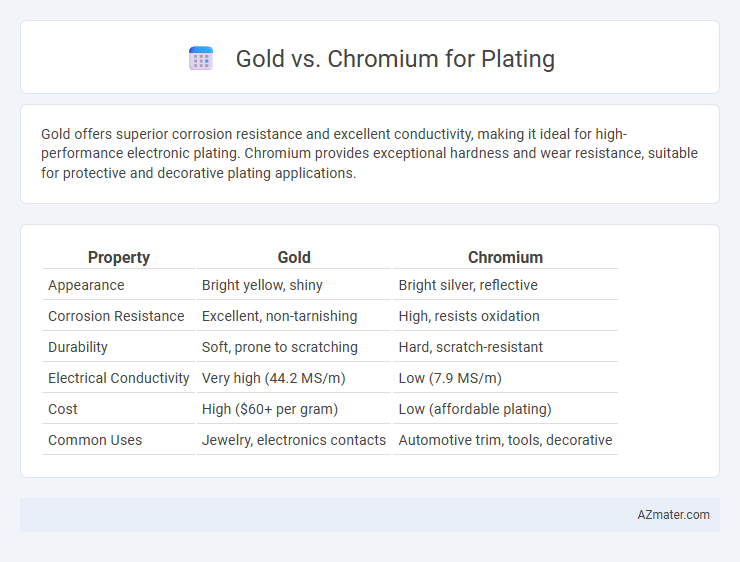Gold offers superior corrosion resistance and excellent conductivity, making it ideal for high-performance electronic plating. Chromium provides exceptional hardness and wear resistance, suitable for protective and decorative plating applications.
Table of Comparison
| Property | Gold | Chromium |
|---|---|---|
| Appearance | Bright yellow, shiny | Bright silver, reflective |
| Corrosion Resistance | Excellent, non-tarnishing | High, resists oxidation |
| Durability | Soft, prone to scratching | Hard, scratch-resistant |
| Electrical Conductivity | Very high (44.2 MS/m) | Low (7.9 MS/m) |
| Cost | High ($60+ per gram) | Low (affordable plating) |
| Common Uses | Jewelry, electronics contacts | Automotive trim, tools, decorative |
Introduction to Metal Plating
Metal plating enhances surface properties such as corrosion resistance, conductivity, and aesthetic appeal by depositing a thin layer of metal onto a substrate. Gold plating offers superior electrical conductivity, excellent corrosion resistance, and a prestigious appearance, making it ideal for high-end electronics and jewelry. Chromium plating provides exceptional hardness, wear resistance, and a reflective, mirror-like finish, commonly used in automotive parts and industrial applications.
Overview of Gold and Chromium Plating
Gold plating offers superior corrosion resistance, excellent electrical conductivity, and a luxurious aesthetic, making it ideal for electronics and decorative applications. Chromium plating provides exceptional hardness, wear resistance, and a reflective, mirror-like finish typically used for automotive parts and industrial tools. Both plating types enhance substrate durability, but gold excels in conductivity while chromium is preferred for mechanical protection.
Key Properties of Gold-Plated Surfaces
Gold-plated surfaces offer exceptional corrosion resistance and excellent electrical conductivity, making them ideal for high-performance electronic components and decorative applications. The natural tarnish resistance of gold ensures long-lasting luster and minimal maintenance, enhancing durability in harsh environments. In comparison to chromium, gold provides superior biocompatibility and a softer, more malleable finish, which is beneficial for precision plating and intricate designs.
Key Properties of Chromium-Plated Surfaces
Chromium-plated surfaces exhibit exceptional hardness and corrosion resistance, making them ideal for protecting underlying metals from wear and environmental damage. The high reflectivity and bright finish of chromium plating enhance aesthetic appeal while providing low friction properties that improve durability in mechanical applications. Chromium's superior oxidation resistance and ability to maintain surface integrity at high temperatures distinguish it from gold plating, which is primarily valued for its conductivity and tarnish resistance.
Durability Comparison: Gold vs Chromium
Gold plating offers excellent corrosion resistance but is relatively soft, making it more prone to wear and scratches over time compared to chromium. Chromium plating provides superior hardness and abrasion resistance, making it more durable for high-wear applications and protecting underlying metals effectively. For long-lasting protection in environments with physical contact or friction, chromium outperforms gold in durability.
Corrosion Resistance: Which Metal Performs Better
Gold offers superior corrosion resistance due to its inert nature, resisting oxidation and tarnishing even in harsh environments. Chromium, while providing good hardness and wear resistance, tends to form a passive oxide layer that can degrade under acidic or salty conditions, leading to potential corrosion. For applications demanding long-term protection against corrosion, gold plating significantly outperforms chromium plating in durability and reliability.
Aesthetic Appeal: Visual Differences
Gold plating offers a rich, warm yellow hue that exudes luxury and timeless elegance, perfect for high-end jewelry and decorative items. Chromium plating delivers a sleek, mirror-like silver finish with a modern, industrial appeal, enhancing automotive parts and contemporary fixtures. The distinct visual differences make gold ideal for classic, opulent designs, while chromium suits minimalist and futuristic aesthetics.
Cost Analysis: Gold vs Chromium Plating
Gold plating typically incurs higher costs due to the precious metal's market price, which can range from $50 to $60 per gram, making it significantly more expensive than chromium plating. Chromium plating costs are generally lower because chromium is abundant and less costly, with prices often under $10 per square meter of plating surface, providing an economical option for corrosion resistance and aesthetic enhancement. Cost analysis reveals gold plating is preferred for high-value applications requiring superior conductivity and corrosion resistance, while chromium plating offers budget-friendly durability and wear resistance.
Common Applications for Each Plating Type
Gold plating is widely used in electronics for its excellent conductivity and corrosion resistance, making it ideal for connectors, circuit boards, and semiconductor components. Chromium plating is common in automotive and industrial applications due to its high hardness, wear resistance, and aesthetic shine, often applied to bumpers, wheels, and machinery parts. Both plating types enhance durability and appearance but serve distinct functional purposes across various industries.
Choosing the Right Plating: Factors to Consider
Choosing the right plating involves evaluating factors such as corrosion resistance, conductivity, and visual appeal. Gold plating offers excellent corrosion resistance and superior electrical conductivity, making it ideal for electronic connectors and jewelry. Chromium plating provides a durable, scratch-resistant surface with a shiny, decorative finish, commonly used in automotive and household fixtures where hardness and wear resistance are critical.

Infographic: Gold vs Chromium for Plating
 azmater.com
azmater.com